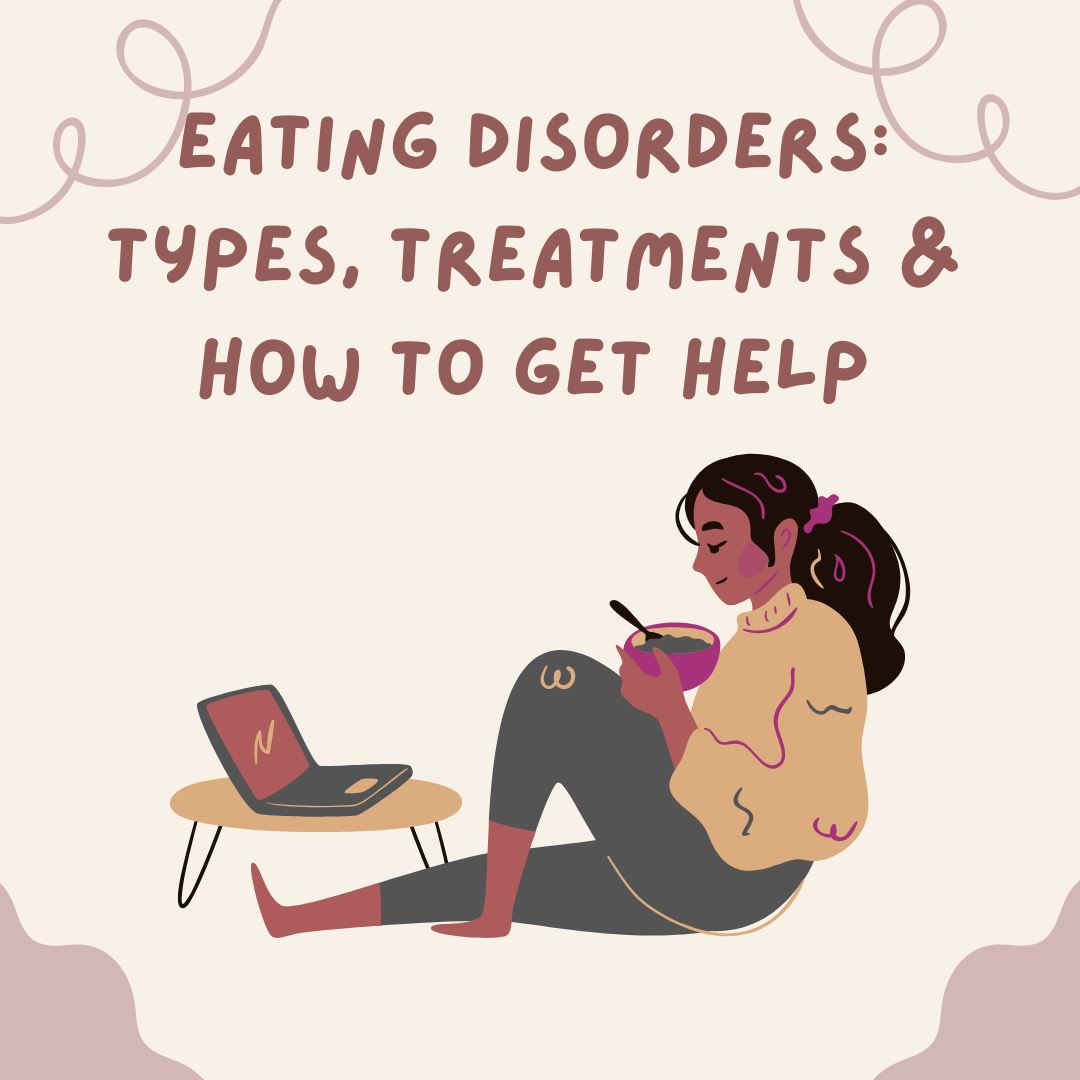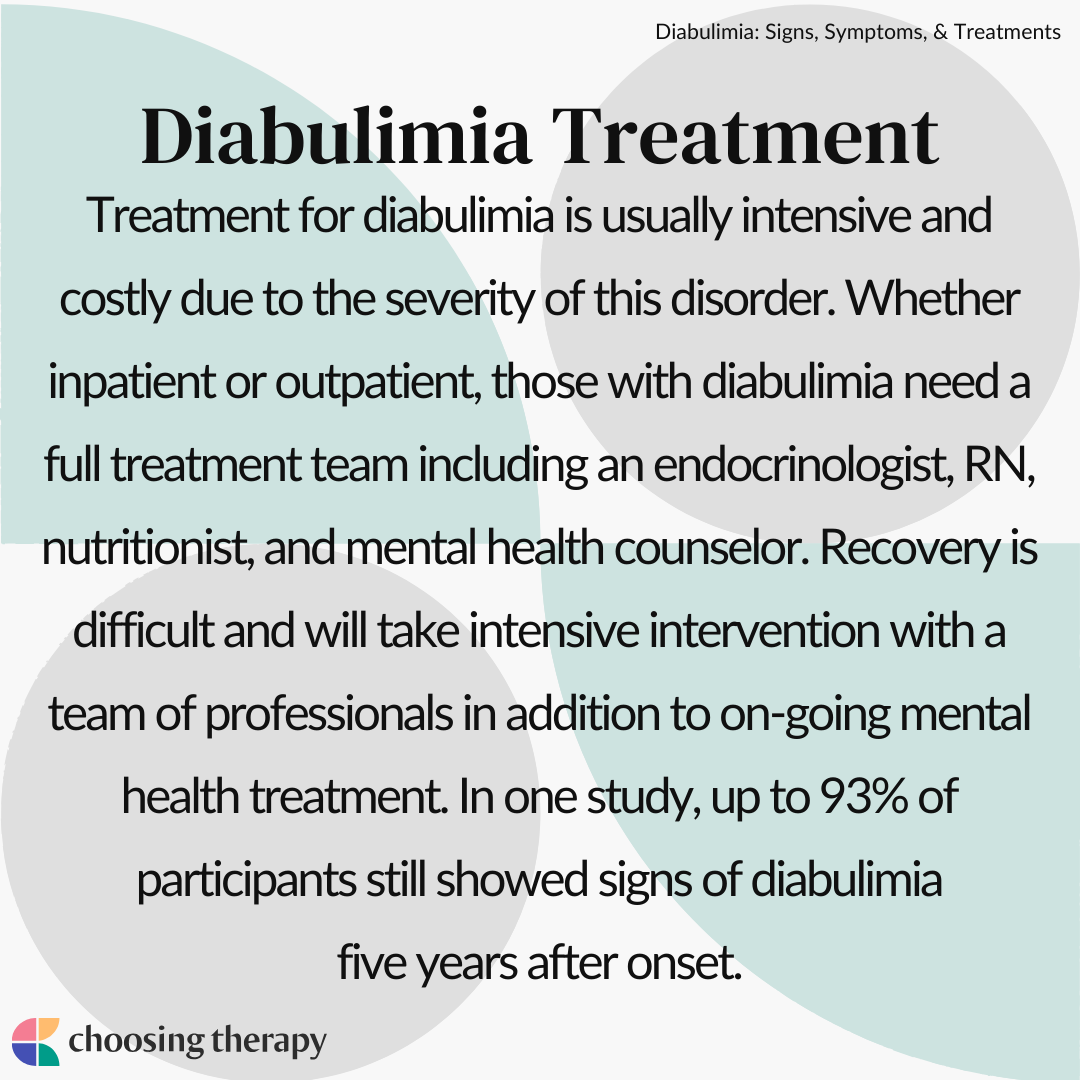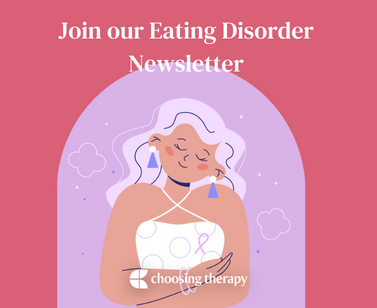Diabulimia is the non-clinical term for people with type 1 diabetes manipulating their use of life-sustaining insulin in the interest of losing weight or out of fear of gaining weight. This dangerous maneuver would be characterized as an “eating disorder not otherwise specified” in the DSM-5, and should be treated with medical stabilization, therapy, and nutrition counseling and education.
Struggling with your relationship with food? Do you find yourself constantly thinking about food or your body? It can be exhausting to have these thoughts. The good news is: you don’t have to feel this way. Take the first step towards healing by taking Equip’s free, confidential eating disorder screener. Learn more
What Is Diabulimia?
Diabulimia is a dangerous combination of a chronic medical illness (type 1 diabetes) combined with an eating disorder. Those with type 1 diabetes will either omit their insulin all together, reduce their insulin intake, or overdose on insulin to offset a carbohydrate binge.1 This can lead to dangerous and severe medical complications. It is not a diagnosis on its own, but falls under the larger umbrella of OSFED.
Those struggling with diabulimia tend to prioritize weight loss and their fear of weight gain so much that they’ll deny these real and dangerous consequences. Diabulimia is described by some as “too tempting” or the “perfect diet” since it is such an accessible way to lose weight that requires no dieting or exercise. In fact, diabulimics can eat in excess and still manage to lose weight, but this isn’t without heavy consequence.
How Common Is Diabulimia?
About one-third of type 1 diabetics will be afflicted with diabulimia.1,2,3 Unfortunately, exact statistics regarding gender or specific factors contributing to prevalence are scant. Research shows that at least 1 out of every 10 people with an eating disorder is male, but this number may be higher for binge eating behaviors.
Does Insulin Make You Gain Weight?
Research shows that insulin therapy can result in weight gain in people with both type 1 and type 2 diabetes.4 This is because insulin is a hormone that impacts how the body absorbs glucose. When people consume additional calories, which can happen when blood sugar levels drop, this can lead to weight gain.
Why Does a Lack of Insulin Lead to Weight Loss?
Diabetes or insulin resistance can lead to weight loss. This is the result of the body being unable to efficiently use glucose as energy. Some diabetes medicines specifically help regulate blood sugar levels, which can result in people being able to lower their insulin dosage. Some of the common medications include metformin, exenatide, and liraglutide.
What Happens If You Stop Taking Insulin Suddenly?
It’s fairly typical for people with diabetes to accidentally skip a dose of insulin or take too little insulin. At this point, the body’s blood glucose levels begin to rise. This can cause immediate symptoms of hunger, thirst, fatigue, blurry vision, and frequent urination. In most cases, this is corrected after properly dosing insulin.
Stopping insulin results in heightened blood sugar levels, which can result in diabetic ketoacidosis. This results in the liver making ketones (acids in the blood) which eventually build up causing serious problems such as dehydration, kidney damage, and electrolyte imbalances. If not treated in a timely and an appropriate manner in a hospital setting, this syndrome can be fatal. Long-term damage from uncontrolled blood sugars may include vision loss, kidney damage, and foot nerve damage.5
Eating Disorder Help
Eating Disorder Treatment That Works – Delivered At Home. Eating disorder treatment is hard – which is why you deserve a team. Equip offers evidence-based care delivered virtually by a five-person care team, so you can achieve recovery without pressing pause on your life. We take insurance! Get a Consultation
Best In-Patient Treatment For Eating Disorders – Find the best local eating disorder treatment center for you. See personalized results and reviews to find the best treatment center covered by your insurance. Start Your Search
Affordable, Online Therapy – Are you or a loved one experiencing eating disorder symptoms? Get help from a licensed therapist. Betterhelp offers online therapy starting at $65 per week. Free Assessment
Diabulimia Symptoms
For the individual struggling with diabulimia, the internal experience may be quite different from what is presented to others. Many symptoms will be physical, however, there’s a significant emotional component to the diabulimia that may go unseen.
Physical Symptoms of Diabulimia
Physical symptoms of diabulimia can include:
- Sudden weight loss
- Intense and persistent thirst
- Nausea
- Vomiting
- Fatigue
- Urinary tract infections (UTIs)
- Vaginal yeast infections
- Dry skin and hair
Emotional & Psychological Symptoms of Diabulimia
Psychological and emotional symptoms of diabulimia can include:
- Fear of gaining weight
- Preoccupation with body image
- Resentment about diabetes
- Increased depression
- Mood swings
- Health anxiety
- Fear of having low blood sugar
- Dieting behaviors
Behavioral Signs & Symptoms of Diabulimia
Behavioral symptoms of diabulimia can include:
- Not giving enough insulin before eating
- Neglecting diabetes care
- Disregarding doctor appointments or medical advice
- Irritation when being asked about health
- Avoiding checking blood sugar or administering insulin in public
- Excessive exercise
- Evidence of binge eating behaviors
- Lying or secrecy about diabetes management
Signs of Diabulimia
Diabulimia, like most eating disorders, can present itself physically as well as mentally and emotionally. Because the episodes of insulin omission are often hidden, there may be some confusion to friends and family observing the individual becoming sicker, losing weight, or changing their personality and behavior.
Outward signs of diabulimia can include:1,2,6
- Weight loss
- Susceptible to illness from weakened immune system
- Frequent urination
- Smell of ketones on breath and sweat (smells a bit like nail polish remover)
- Binging on carbs, but noticeable weight loss
- Not filling insulin prescriptions or finding excess bottles of insulin around
- Fainting, dizziness, less alert
- Mood swings
- Avoiding testing blood sugar or evasive about reporting blood sugar levels
- Irrational fear that taking insulin will make the individual gain weight
- Excessive hospitalizations from any range of medical issues
How Diabulimia Develops
Those with diabulimia remain unique individuals with a shared diagnosis. Not every person will fit the criteria and the eating disorder isn’t always preventable. That said, research has shown some are more at risk than others. Of course, the primary risk is being diagnosed with type 1 diabetes. Prevention must start there since upwards of 30% of diabetics may manipulate their insulin with intentions to lose weight.
A diagnosis of diabetes type 1 often occurs in childhood or early teens, so from a young and impressionable age the patient is being taught to not only watch their weight and food intake, but to obsess over it.1 This alone predisposes a person to eating disorder, akin to excessive dieting or counting calories. Research also shows that women and LGBTQ+ individuals are more susceptible to diabulimia.1,7
Risk Factors for Diabulimia
Other risk factors for developing diabulimia include:
- Diabetes burnout: Diabetes burnout refers to the emotional fatigue and resentment that sometimes coincides with having to manage diabetes.
- Wanting a sense of control: Diabetes can make someone feel out of control with their life and body, and diabulimia can offer a sense of control.
- Body image issues: Weight gain or the fear of weight gain may trigger body image issues.
- Weight gain after initial diabetes treatment: Discomfort around weight gain may coincide with diabulimia.
- Environmental and cultural factors: Social attitudes around disordered eating or cultures that embrace thinness may exacerbate diabulimia symptoms.
Complications of Diabulimia
Diabulimia is an incredibly serious condition. The most severe effects of diabulimia include blindness, stroke, or rapid death.
- Diabetes-related ketoacidosis (DKA): DKA happens when the body lacks proper insulin to permit blood sugar into the cells to use for needed energy. This can result in excessive ketones.
- Severe dehydration: Severe dehydration can be fatal, and it coincides with excessive thirst, low blood pressure, and a fever.
- Slow wound healing: Diabulimia can slow wound healing, which may magnify the risk of inflammation and scarring.
- Staph and other bacterial infections: People with diabulimia may be more prone to staph and other bacterial infections due to weakened immunity.
- Yeast infections: Because diabulimia compromises the immune system, some people may be more susceptible to yeast infections.
- Loss of muscle mass: Losing excessive weight due to diabulimia may result in losing essential muscle mass.
Long-Term Consequences of Diabulimia
If diabulimia persists long-term, it can have severe consequences, including:
- Diabetes-related retinopathy: This condition refers to the vision loss and blindness in people with diabetes. People with diabulimia may be at a higher risk for diabetes-related retinopathy.
- Peripheral neuropathy: This condition refers to the loss of nerve cells, and those with diabulimia may be at an increased risk for it occurring.
- Gastroparesis: Gastroparesis is the paralysis of the stomach, and it can affect your ability to digest food properly.
- Heart disease: Diabulimia can affect cardiovascular health, which may exacerbate or cause heart disease.
- Kidney disease: Diabulimia can result in kidney damage, and the symptoms can be permanent.
- Liver disease: Diabulimia can result in liver disease, and it’s possible to develop nonalcoholic fatty liver disease.
Do you have a dietitian on your eating disorder recovery team? Nourish dietitians have experience with Binge Eating, Anorexia, Bulimia, and AFRID. Covered by insurance. 94% of Nourish patients pay $0 out of pocket. Visit Nourish
How Is Diabulimia Diagnosed?
While there’s no formal diagnosis for diabulimia in the DSM-5, a medical professional would likely diagnose “other specified feeding or eating disorder.” A doctor or clinician can determine from there which sub-category it best fits. Insulin deprivation alone would be considered a purging disorder. If insulin flooding pairs with a binge episode, the eating disorder may be considered bulimia nervosa or binge-eating disorder. If there’s low body weight, significant weight loss, abstinence from food, and also insulin deprivation, this may better fit criteria for anorexia nervosa or atypical anorexia.
To be diagnosed with “other specified feeding or eating disorder,” the behavior must cause marked impairment in at least one area of functioning: social, occupational, and/or relational. The individual must also have type 1, insulin dependent diabetes.8
Diabulimia Treatment
Treatment for diabulimia is usually intensive and costly due to the severity of this disorder. Whether inpatient or outpatient, those with diabulimia need a full treatment team including an endocrinologist, RN, nutritionist, and mental health counselor. Recovery is difficult and will take intensive intervention with a team of professionals in addition to on-going mental health treatment. In one study, up to 93% of participants still showed signs of diabulimia five years after onset.3
Medical Stabilization & Hospitalization or Inpatient Treatment
If the patient can not commit to using the minimum therapeutic dose of insulin daily in an outpatient setting, they will need to be treated at an eating disorder recovery center, inpatient rehabilitation, or inpatient hospitalization.9 Individuals may find themselves in need of urgent and intensive medical and psychological intervention, especially if they continue to refuse the minimum dose of insulin.9 In this case, the person’s food and insulin will be heavily monitored by a medical team of nurses and doctors for a period of time long enough to stabilize the medical condition. The person may also receive intensive psychological attention with daily support groups and therapy sessions.
Eating disorder recovery centers can offer a fine-tuned and interdisciplinary approach to those struggling with diabulimia. This would include support groups, individual therapy, medication or psychiatric assessment, and a nutritionist on-hand. This may be a good option for the individual looking for a very in-depth, tailored, and focused experience of recovery.
Therapy for Diabulimia
Patients may step down to intensive day programs with groups and therapy daily, up to five days per week. The least intensive treatment option will be weekly or bi-weekly psychotherapy with a psychologist, social worker, or mental health counselor, ideally in conjunction with one’s medical doctor.
Here are forms of therapy for diabulimia:
- CBT: CBT for eating disorders deals with the idea that irrational, repressed thoughts trigger emotional responses, which trigger unwanted behaviors (e.g., poor insulin management). CBT is typically short-term, approximately 6-12 sessions. The goal is to confront irrational thoughts and uncover underlying emotional issues.10,11
- Psychoeducation: Psychoeducation refers to teaching people about managing their health and well-being. This can be important for diabetics to thoroughly understand the risks associated with their behavior.
- Family-based treatment models: Family-based therapy specific to eating disorders, like the Maudsley method, can be helpful when children or teenagers are diabetic. This type of therapy focuses on supporting everyone in the family to effectively understand and manage diabetes.
- Long-term psychoanalysis: Psychoanalysis may be open-ended and can help uncover the root of the eating issues. Long-term therapy will be an important part of the recovery process as it is important to understand how these issues arose and possible solutions to underlying issues, including fear of weight gain, pressure to be thin, and pressure to gain approval.
- Support groups: support groups like “Diabuddies” can be helpful. These are free online or in person groups where young people with diabetes type 1 can connect and offer each other understanding and encouragement.
Nutrition & Diabetes Management Education
Nutrition and diabetes management education can play a pivotal role in improving someone’s diabulimia treatment. People with diabetes may benefit from understanding the nuanced interplay between food, nutrition, insulin, and overall health. A skilled dietitian blends their trained expertise with compassionate support. The goal is for you both to be on the same page oriented toward wellness.
Dietitians have different specialties, and it’s especially important to find a registered dietitian who specializes in both diabetes and eating disorders. You can ask your doctor or endocrinologist for a recommendation. You can also search for dietitians in your local area to see if someone has a referral for a specialist.
Are you or a loved one experiencing eating disorder symptoms?
A trained therapist can help! BetterHelp has over 20,000 licensed therapists who provide convenient and affordable online therapy. BetterHelp starts at $65 per week. Take a Free Online Assessment and get matched with the right therapist for you.
How to Get Help for Diabulimia
Diabulimia requires urgent intervention, yet may be difficult to diagnose and treat. Often, someone’s medical doctor responsible for helping the individual manage their type 1 diabetes is the first line of defense. As mentioned earlier, a medical doctor may overlook the underlying psychological issues around manipulating one’s insulin and write off the behavior as non-compliance.
A mental health professional may also overlook this behavior since it is not clearly outlined in the DSM. There is strong argument to add this diagnosis to the DSM as some patients have reported being turned away from treatment since diabulimia is not considered typical starving or purging behavior.12
Ideally, in either setting, the patient is being screened for other underlying emotional symptoms like anxiety, depression, and suicidal ideation, which can come with the stress of managing one’s diabetes. The patient’s PCP or endocrinologist should refer them to necessary mental health treatment.
Cost of Diabulimia Treatment
Cost of treatment can range from free to the tens of thousands, depending on the level of care you receive. Typically support groups are donation based or low cost. You can find support groups in your area through the Diabulimia Helpline or NEDA Support Groups.9 The cost of a therapist and nutritionist would range from a small co-payment to $100-$200 per session.
Inpatient rehab, partial hospitalization, or intensive outpatient treatment will be indicated when the patient refuses to take a minimum therapeutic dose of insulin daily.9 These treatments can cost thousands of dollars even with medical insurance and are reserved for those whose addictive behaviors put them in life-threatening emergency situations.
Health insurance may cover some or all of the associated costs. While the expense of treatment can be a deterrent, not getting treatment is costly as well, with sufferers experiencing blindness, loss of limbs, coma, or even fast death.
Supporting a Loved One With Diabulimia
Diabulimia is a dangerous eating disorder and if one is mismanaging their insulin, they may need emergency intervention. Mandated treatment is difficult for friends and family who may feel that they’re betraying their loved one. That is why it is only reserved for the most urgent life and death situations, which unfortunately diabulimia can easily become. While it can be difficult to know how to help someone with an eating disorder, showing up consistently and listening to them are often the first steps.
Here are ways you can help a loved one with diabulimia:
- Disclose information about this person’s condition to their doctor and/or endocrinologist right away
- Let them know you are there to support them and be open to listening13
- Inform yourself on signs and symptoms of diabulimia so you can answer questions they may have
- Don’t legitimize their dangerous relationship with insulin omission
- If they are ready to admit they have a problem, join them in their more rational thinking and motivate them to engage in treatment
- Lend a listening ear, help connect to treatment, and provide positive reinforcement and encouragement along the way
- Be aware of the possibilities of relapse and remain supportive as set-backs in the process are inevitable3
What Is the Outlook for Someone With Diabulimia?
Diabulimia is a serious condition that can have fatal consequences. This condition can rapidly progress, and treatment may be essential for preserving one’s physical and emotional health. The right treatment, which may include a combination of therapy and nutritional support, can make a significant difference and help you live well despite having diabetes.
In My Experience
Additional Resources
To help our readers take the next step in their mental health journey, Choosing Therapy has partnered with leaders in mental health and wellness. Choosing Therapy is compensated for marketing by the companies included below.
Eating Disorder Treatment
Eating Disorder Treatment That Works – Delivered At Home. Eating disorder treatment is hard – which is why you deserve a team. Equip offers evidence-based care delivered virtually by a five-person care team, so you can achieve recovery without pressing pause on your life. We take insurance! Get a Consultation
In-Patient Treatment For Eating Disorders
Find the best local eating disorder treatment center for you. See personalized results and reviews to find the best treatment center covered by your insurance. Start Your Search
Online Talk Therapy
Are you or a loved one experiencing eating disorder symptoms? Get help from a licensed therapist. Betterhelp offers online therapy starting at $65 per week. Free Assessment
Eating Disorders & OCD
Is your eating disorder being made worse by OCD? Almost half of people with eating disorders also have OCD. Intrusive thoughts, including constantly thinking about food or your body, may be a sign of OCD. NOCD Therapists specialize in treating OCD and have an understanding of eating disorders. To learn more about receiving an OCD diagnosis and treatment options, schedule a free 15 minute call. NOCD is covered by many insurance plans. Visit NOCD
Best Online Therapy Services There are a number of factors to consider when trying to determine which online therapy platform is going to be the best fit for you. It’s important to be mindful of what each platform costs, the services they provide you with, their providers’ training and level of expertise, and several other important criteria.

Eating Disorders: Types, Treatments & How To Get Help
If you or a loved one are dealing with an eating disorder, know you’re not alone. Treatment can significantly help improve thought patterns and symptoms that can contribute to eating disorders, and having a robust care team can be an effective prevention strategy long-term.
Find a therapist for eating disorders
Get the help you need from a therapist near you
City or zip Search







